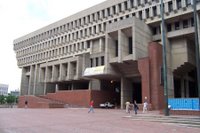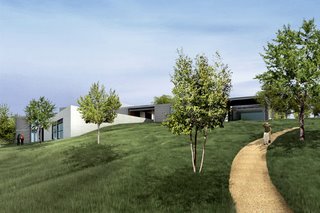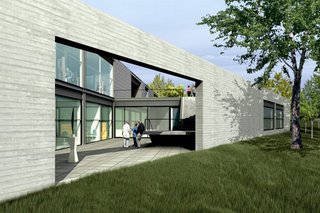 This week he was in town with a posse of consultants, officials, Japanese media, etc. and we all followed him up to the building site near Stone Hill. It felt a little bit like those scenes in 8½ when Marcello Mastroianni is taking the crowd around the movie set. There were lots of people with cameras and microphones milling about, all following around a mysterious genius who drops cryptic remarks around and seems both nervous and perfectly at home at the center of attention.
This week he was in town with a posse of consultants, officials, Japanese media, etc. and we all followed him up to the building site near Stone Hill. It felt a little bit like those scenes in 8½ when Marcello Mastroianni is taking the crowd around the movie set. There were lots of people with cameras and microphones milling about, all following around a mysterious genius who drops cryptic remarks around and seems both nervous and perfectly at home at the center of attention.
I should say that architecture is one of the more interesting of the arts in my mind. I wish I could say that there was one building or experience that won me over forever, but I think it was a gradual think. I remember I agreed with little thought when I read about how the Situationists were into architecture as the purest total artform because of its power to immerse and dictate experience, and by the time I made my first trip to
So it was great that Ando was designing something like this on my beat. It would be one of those buildings serious architecture nerds are going to drive out of their way to see, there will be fancy photographs of it at sublime angles in expensive glossy magazines. And I’ll get to follow it from the start. Though I have to say I was skeptical at first. Architectural drawings, no matter how fancy and chic, seem silly to me. I always get a kick out of the faceless CGI people walking about like ghosts. Here are ones for the
But as I learned more about it, the more I came to buy into it. When I write I usually try to find the thing that interests me the most and start from that. Usually, what interests me would not interest anyone else, which is why daily journalism is probably not my perfect metier. In this case, the interesting thing to me is the concrete.
 When you think about concrete as a building material a lot of very negative things probably pop into your head. Like the Boston City Hall, a building which has its unique charms in terms of being like a fat upside ziggurat suspended in mid-air, but the material looks cruddy when it rains, and it is almost certainly an inappropriately brash thing to have in the center of America’s most European and traditional cities.
When you think about concrete as a building material a lot of very negative things probably pop into your head. Like the Boston City Hall, a building which has its unique charms in terms of being like a fat upside ziggurat suspended in mid-air, but the material looks cruddy when it rains, and it is almost certainly an inappropriately brash thing to have in the center of America’s most European and traditional cities.
So for awhile I had a hard time understanding how Ando’s building on Stone Hill would involve concrete. How could that work? But the interesting thing is that Ando’s concrete is nothing like the gravelly crumbly stuff on sidewalks. As with the Pulitzer Foundation for the Arts in
What Ando is doing here is creating a sense of harmony with the the surrounding hills. Based on the mock-ups at the site, the forms will be made of Yellow Pine, and will give the finished concrete – which again, is more like a dense and molded stone that anything you’d see out on the street – a horizontal plank appearance with the grain textures embedded. That will work with the cedar planking in other parts of the building, along with the glass and metal elements, to create something that fits in.
It also seems that for all his poetic license – last year Ando went on about the building as a jewel hidden in the landscape – it does seem to be in harmony with the surroundings. While a construction site never looks in harmony with anything, and we couldn’t see the promised views because it was overcast and drizzly, it should work out. It is not a high building, it is fit carefully ino the hillside, and there will be only small roads and paths to get up there. You won’t be able to see it from the rest of the
It all seems to be coming together pretty well. And perhaps the backhanded fun of this is that you just won’t know how the thing is work until after the $25 million is spent and there’s no turning back.


No comments:
Post a Comment